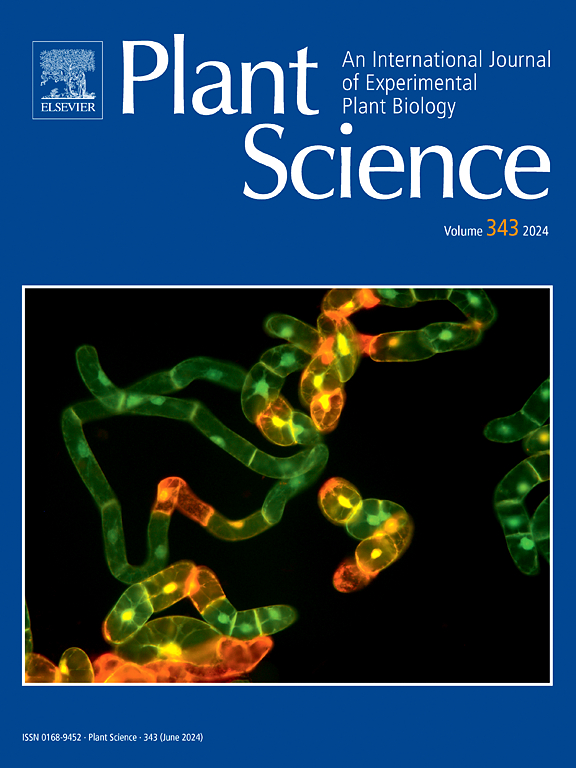E3泛素连接酶APC3及其相互作用蛋白对毛茛四孢子形成和释放的调控研究。
IF 4.2
2区 生物学
Q2 BIOCHEMISTRY & MOLECULAR BIOLOGY
引用次数: 0
摘要
E3泛素连接酶在高等动植物的发育过程中起着重要的作用。我们最近发现,作为后期促进复合体/环体亚基的E3泛素连接酶APC3参与了四孢子的形成和释放,这是一种重要的经济红藻。在四孢子形成和释放过程中,GlAPC3在低育性品种981和高育性品系WLP中表现出相反的表达模式,在981中表达上调,在WLP中表达下调。检测到与染色体分离相关的5个蛋白SMC3、NUF2、APC2、APC8和APC10与APC3相互作用,且均位于细胞核内。NUF2和CDC20是APC3的底物,与含有2或4个泛素的泛素链赖氨酸-11、赖氨酸-48和赖氨酸-63结合。APC3泛素化的关键氨基酸包括第474位天冬氨酸、第502位酪氨酸和第506位白氨酸,任何突变都会导致泛素化的丧失。在四孢子形成和释放过程中,SMC3仅在981株中显著上调,四孢子释放数量较少。NUF2和APC2仅在WLP中显著下调,且释放频率高,释放量大。提示APC3、SMC3和NUF2可能是影响Gp育性的关键基因。lemaneiformis。本研究有助于探讨APC3与SMC3和NUF2通过染色单体分离过程调控四孢子形成和Gp释放的机制。lemaneiformis。本文章由计算机程序翻译,如有差异,请以英文原文为准。
Studies on the regulation of E3 ubiquitin ligase APC3 and its interacting proteins on the tetraspore formation and release in Gracilariopsis lemaneiformis (Rhodophyta)
E3 ubiquitin ligases play significant roles in development of high plants and animals. We recently found that E3 ubiquitin ligase APC3, the subunit of the anaphase promoting complex/cyclosome, was involved in tetraspore formation and release in Gracilariopsis lemaneiformis, an economically important red alga. GlAPC3 showed opposite expression pattern in low-fertility cultivar 981 and high-fertility strain WLP during the process of tetraspore formation and release, up-regulated in 981 and down-regulated in WLP. Five proteins related to chromosome segregation, SMC3, NUF2, APC2, APC8 and APC10, were detected to interact with APC3, which were all located in the nucleus. NUF2 and CDC20 were the substrates of APC3, combined with Lysine-11, Lysine-48 and Lysine-63 of ubiquitin chains containing two or four ubiquitin. The key amino acids for ubiquitination of APC3 covered 474th Aspartate, 502nd tyrosine and 506th leucine, any mutation of which resulted in a loss of ubiquitination. During the process of tetraspore formation and release, SMC3 was significantly up-regulated only in 981, low number of tetraspore release. NUF2 and APC2 were significantly down-regulated only in WLP, with high frequency and large amount of tetraspores release. The data provided that APC3, SMC3 and NUF2 might be the key gene affecting the fertility of Gp. lemaneiformis. The study helps to explore the regulation mechanism of APC3 with SMC3 and NUF2 by the process of chromatids segregation in regulating tetraspore formation and release of Gp. lemaneiformis.
求助全文
通过发布文献求助,成功后即可免费获取论文全文。
去求助
来源期刊

Plant Science
生物-生化与分子生物学
CiteScore
9.10
自引率
1.90%
发文量
322
审稿时长
33 days
期刊介绍:
Plant Science will publish in the minimum of time, research manuscripts as well as commissioned reviews and commentaries recommended by its referees in all areas of experimental plant biology with emphasis in the broad areas of genomics, proteomics, biochemistry (including enzymology), physiology, cell biology, development, genetics, functional plant breeding, systems biology and the interaction of plants with the environment.
Manuscripts for full consideration should be written concisely and essentially as a final report. The main criterion for publication is that the manuscript must contain original and significant insights that lead to a better understanding of fundamental plant biology. Papers centering on plant cell culture should be of interest to a wide audience and methods employed result in a substantial improvement over existing established techniques and approaches. Methods papers are welcome only when the technique(s) described is novel or provides a major advancement of established protocols.
 求助内容:
求助内容: 应助结果提醒方式:
应助结果提醒方式:


